Posted by: Northwest Eye in General on July 14, 2025
Overview
When considering LASIK and PRK, it’s natural to have questions and concerns about the differences between these procedures. Both techniques offer unique benefits, and understanding them can help you make an informed decision.
- LASIK involves the creation of a flap in the cornea, which often leads to quicker recovery times. Many patients experience clear vision within just a few hours after the procedure, contributing to a high satisfaction rate.
- On the other hand, PRK is a flapless option that may be ideal for individuals with thinner corneas. While it requires a longer healing period, many find that the gradual recovery process is worth it. It’s common to feel apprehensive about the healing time, but rest assured that many patients have successfully navigated this journey and achieved excellent results.
We understand that each patient’s needs are unique, and we are here to help you through this process. If you have further questions or need support, please don’t hesitate to reach out to us. Your comfort and confidence in your choice are our top priorities.
Introduction
Choosing between LASIK and PRK is a significant decision for anyone looking to improve their vision and lessen their reliance on corrective lenses. With the remarkable advancements in laser technology, both procedures have become increasingly popular. However, they differ in their techniques and recovery experiences.
We understand that this choice can feel overwhelming, and you may be wondering which procedure aligns best with your unique eye health and lifestyle needs. Exploring the differences between LASIK and PRK can help guide you toward clearer vision, but it’s essential to understand the advantages and potential drawbacks of each option to make an informed decision.
We are here to help you through this process.
Define LASIK and PRK: Understanding the Basics
Laser-Assisted In Situ Keratomileusis (LASIK) is a widely recognized refractive eye surgery designed to correct vision issues such as myopia, hyperopia, and astigmatism. We understand that considering eye surgery can be daunting, but this procedure begins with the creation of a thin flap in the cornea, which is then lifted to allow a laser to reshape the underlying corneal tissue. This method allows for quick recovery and minimal discomfort, making it a favored option for numerous individuals. In fact, over 90 percent of individuals undergoing LASIK attain 20/20 vision or better after surgery, with satisfaction rates surpassing 95%.
On the other hand, PRK, or Photorefractive Keratectomy, is another effective laser eye surgery that corrects refractive errors by removing the outer layer of the eye’s surface (the epithelium) before reshaping it with a laser. It’s common to feel uncertain about which procedure is right for you when comparing LASIK vs PRK. Unlike LASIK, PRK does not require forming a flap, which can be beneficial for individuals with thinner corneas or those involved in contact sports. However, PRK typically requires a longer recovery period, as the epithelium takes time to regenerate.
Both laser eye surgery and PRK aim to lessen reliance on glasses or contact lenses, but their differing techniques lead to distinct recovery experiences. Current trends suggest an increasing inclination for LASIK vs PRK, highlighting LASIK’s rapid recovery and high satisfaction levels, while PRK continues to be a suitable alternative for particular individual requirements.
For individuals with conditions like Keratoconus, understanding the health of the cornea is crucial. We recognize that this condition causes the cornea to thin and develop an abnormal curvature, which can complicate the . Symptoms of Keratoconus, such as blurry or double vision and light sensitivity, can be concerning. Specialized treatments, including specially fitted contact lenses or Corneal Collagen Cross-Linking, may be necessary to manage Keratoconus effectively.
As advancements in laser technology continue to evolve, both LASIK and PRK are becoming increasingly safe and effective, with complication rates for LASIK remaining below 1%. It is important to note that around 0.3 percent of people may experience serious complications, including dry eyes and infection. Real-world examples show that patients often experience life-changing improvements in their vision. We encourage you to consult with an experienced ophthalmologist to determine the best option for your individual needs.
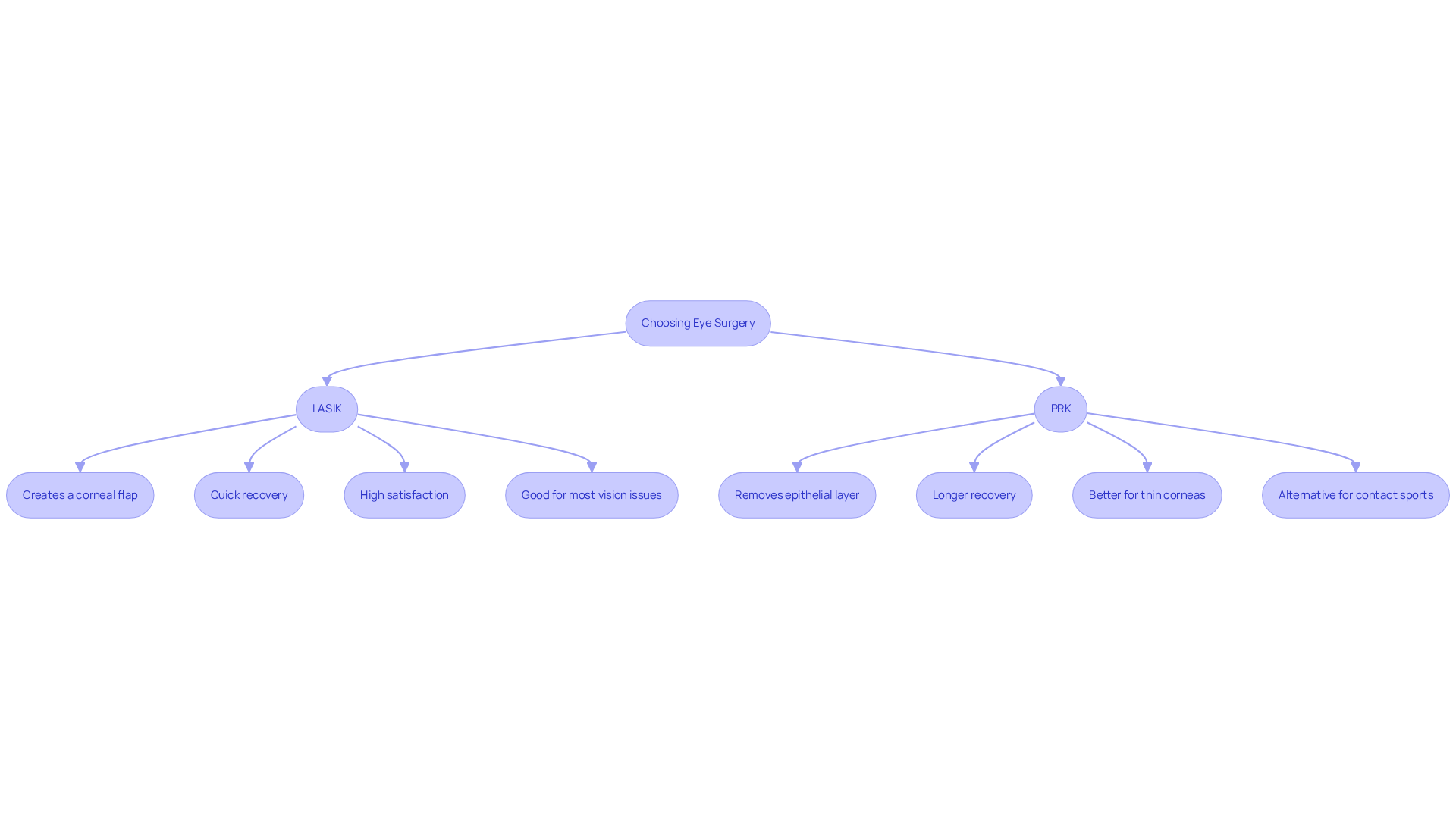
Compare the Procedures: How LASIK and PRK Are Performed
The LASIK procedure starts with the application of anesthetic eye drops, designed to numb the eye and ensure your comfort. Following this, a microkeratome or femtosecond laser is used to create a thin flap in the outer layer of the eye, which is then carefully lifted. This transparent dome-shaped layer at the front of your eye is crucial for focusing light and protecting the inner structures. It’s important to maintain a balance between the fluid entering and exiting the eye, as this is vital for its health and function.
Once the flap is lifted, the excimer laser is employed to reshape the eye’s surface, correcting the refractive error. Afterward, the flap is repositioned, initiating the healing process. In contrast, PRK also begins with anesthetic drops, but instead of forming a flap, the outer epithelial layer of the eye’s surface is gently removed. The excimer laser then reshapes the cornea directly. To aid in healing, a bandage contact lens is often placed on the eye following the procedure.
The main difference when comparing LASIK vs PRK lies in the flap creation; this distinction affects recovery time and the suitability of each technique for different individuals. It’s common to feel uncertain about what to expect during recovery. For those undergoing PRK, the recovery time is generally longer, with around 70% healing after one week and 90% after one month. In contrast, LASIK recipients often experience clear vision within just a few hours when comparing LASIK vs PRK.
This makes PRK a favorable option for individuals with thinner corneas or those who participate in high-contact sports, as it eliminates the risk of flap-related complications. Importantly, both procedures offer substantial benefits tailored to individual needs. In fact, 99 percent of individuals who underwent PRK surgery reported satisfaction with their outcomes. We understand that individuals with , such as -8.00 or -9.00, may find PRK to be a more suitable choice.
We are here to help you through this process, ensuring you feel informed and supported every step of the way.
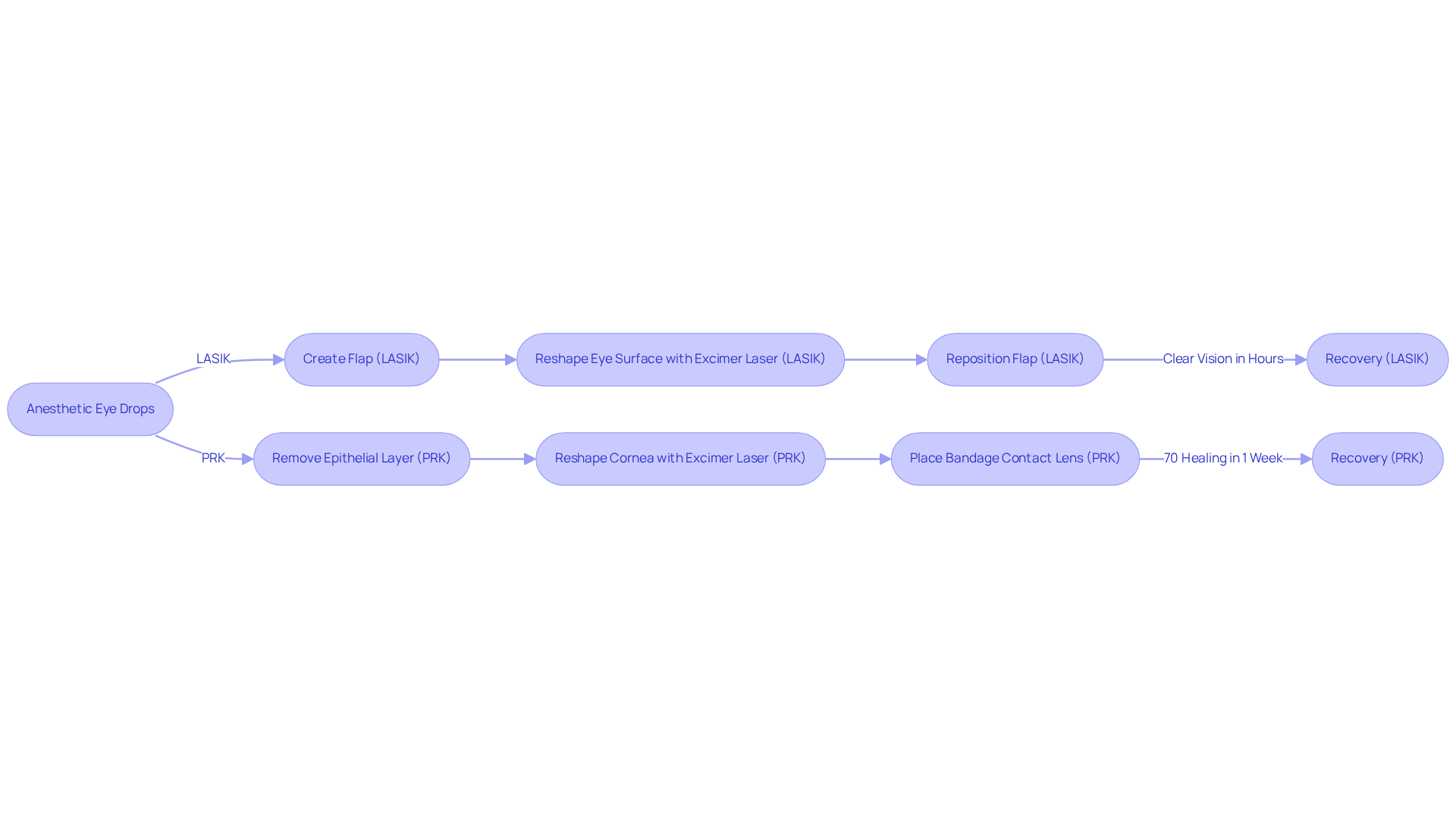
Examine Recovery Times: What to Expect After LASIK and PRK
Recovery times can vary significantly when considering LASIK vs PRK, and we understand that this can be a concern for many individuals. After laser eye surgery, you may notice a swift improvement in your vision, with many achieving clear sight within just a few hours to a few days. Most people are able to return to their normal activities within a day or two, although it’s important to remember that complete healing can take several weeks to months.
In contrast, if you choose PRK, you might experience a longer recovery period. Initial healing typically takes about 3 to 5 days, during which your vision may be blurry. It’s common for it to take about a month before you see clearly after PRK, with optimal clarity often reached within three to six months. This extended recovery time is due to the removal of the epithelial layer, which requires time to regenerate.
As Dr. Tom Tooma highlights, while PRK offers a longer recovery, it’s essential to be prepared for slight discomfort and varying vision during the early healing stage. Additionally, around 10% of individuals undergoing PRK may experience mild to moderate pain or discomfort in the first 24 to 36 hours following the procedure. Understanding these distinctions is vital as you consider your options regarding LASIK vs PRK for laser vision correction. We are here to and ensure you feel supported every step of the way.
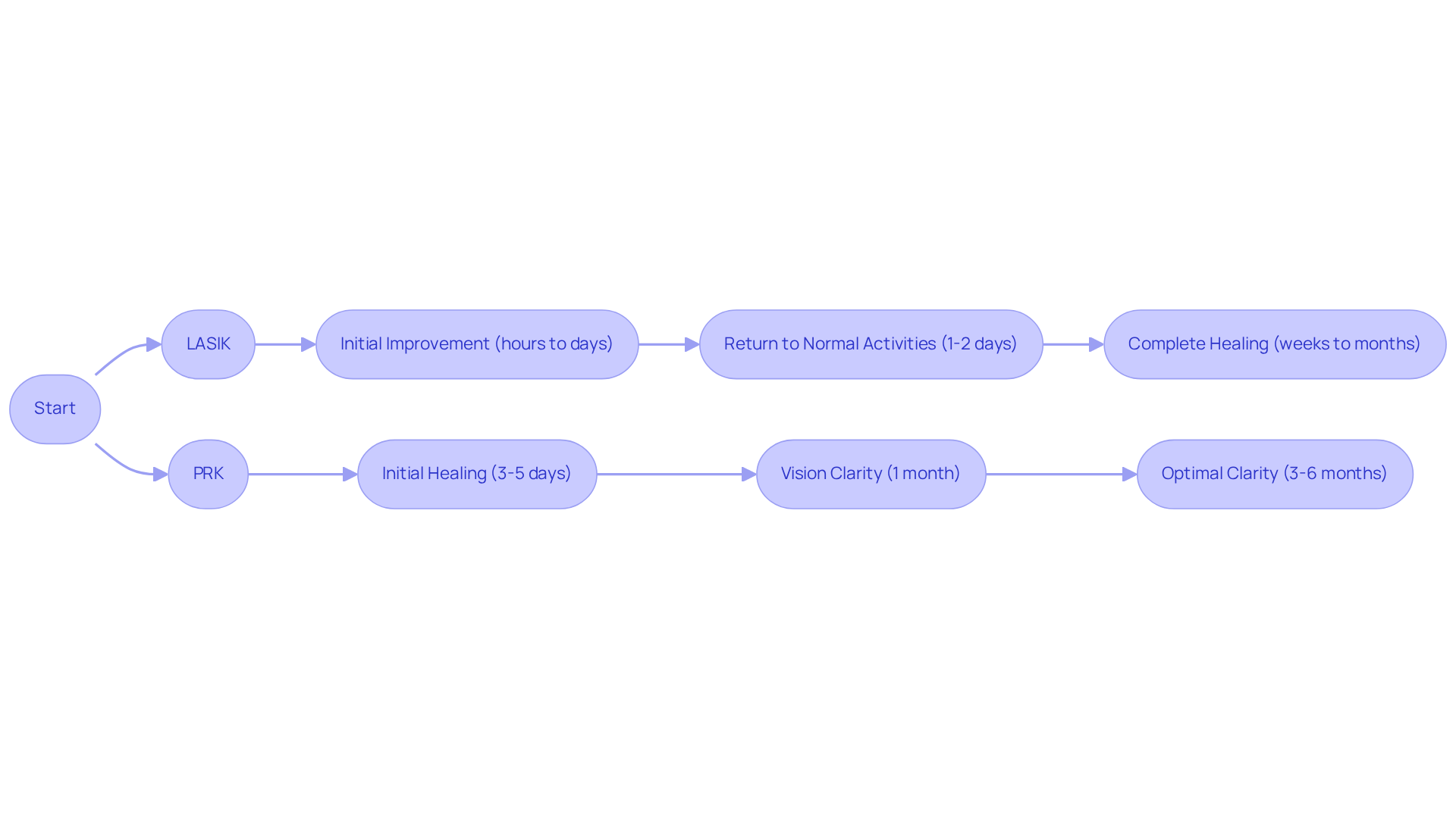
Assess Risks and Side Effects: Evaluating Safety Concerns
Both laser eye surgery and PRK, as well as lasik vs prk, come with their own set of risks and potential side effects, and it’s completely natural to have concerns about them. Typical side effects of laser eye surgery may include:
- Dry eyes
- Glare
- Halos
- In rare cases, flap issues like dislocation or wrinkles
We understand that as many as 30 percent of individuals undergoing this procedure might experience dry eye symptoms for up to three months after surgery. While most side effects tend to be temporary, some may face long-term issues. Dr. Morris Waxler, a former FDA official, has expressed serious concerns regarding the risks associated with eye surgery, stating, ‘Complications are serious.’ However, it’s important to note that these complications are much less common than the side effects.
On the other hand, when considering lasik vs prk, PRK is a flapless procedure, which means it eliminates flap-related complications. Yet, it may lead to other side effects, such as:
- Prolonged discomfort
- Haze
- A slower visual recovery
It’s common to feel that individuals undergoing PRK might experience more significant post-surgical discomfort compared to those who opt for lasik vs prk. Despite these differences, both procedures, lasik vs prk, have high satisfaction rates, with lasik boasting a 96 percent success rate and PRK also showing favorable outcomes.
Understanding these risks is crucial for making informed choices based on your unique situation. We are here to help you through this process, ensuring that you feel supported every step of the way.
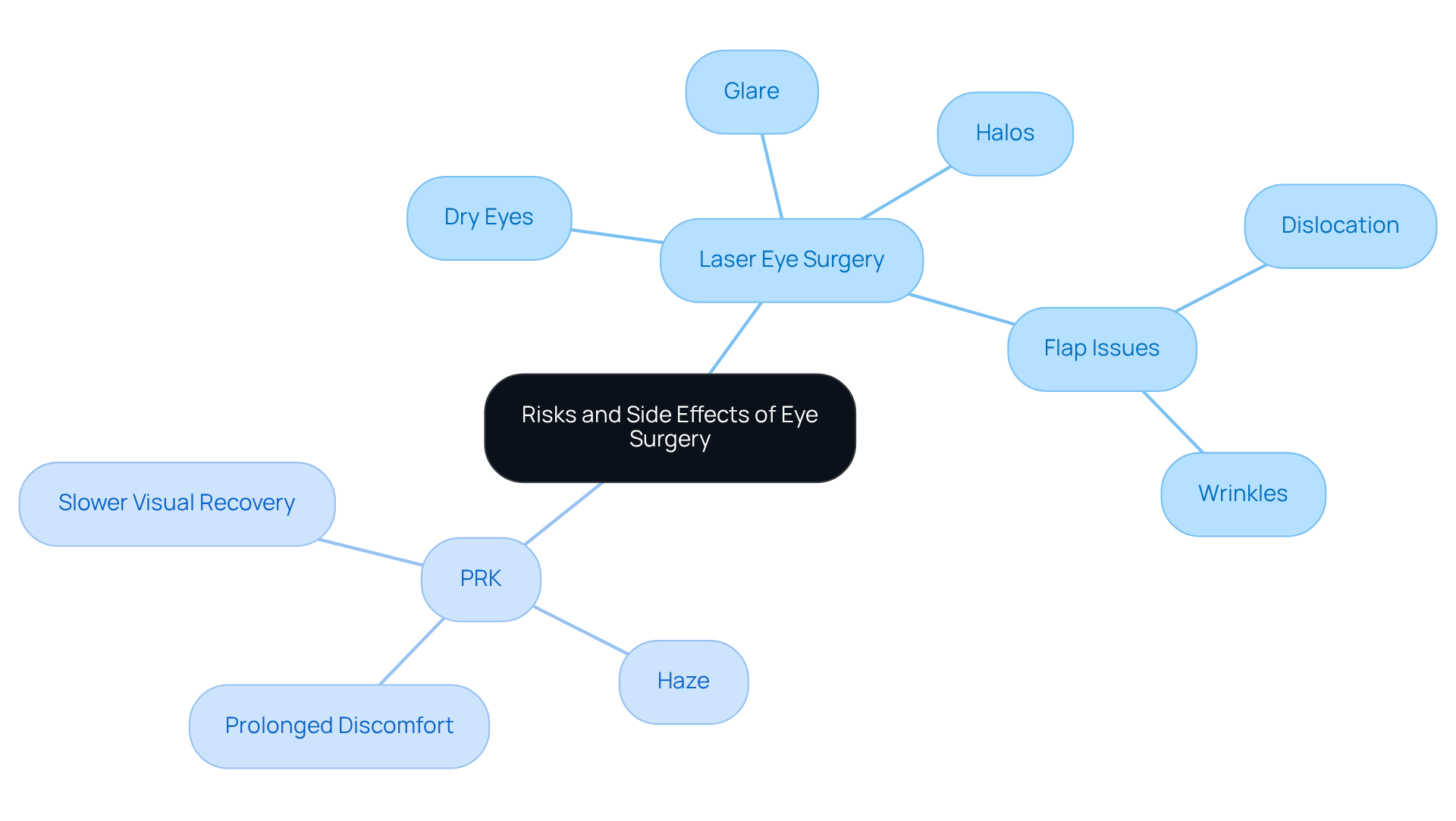
Summarize Pros and Cons: Choosing Between LASIK and PRK
When selecting between LASIK vs PRK as laser eye surgery options, we understand that this decision can feel overwhelming. It’s important to consider both the advantages and disadvantages of each option.
- LASIK offers a swift recovery, minimal discomfort, and quick visual enhancement, with about 90% of individuals achieving 20/20 vision or better after the procedure. This option is favored by many, boasting a satisfaction rate of approximately 96%. However, it does carry risks associated with flap creation and may not be suitable for those with thin eye layers.
- On the other hand, PRK might be the right choice for individuals with thinner corneas or those at risk for flap complications. While it has a , it does require a longer recovery time and may involve more initial discomfort. Common minor side effects, such as dry eyes and glare, typically resolve over time.
Ultimately, the decision regarding LASIK vs PRK should be based on your unique eye health, lifestyle, and personal preferences. To help you navigate this process, we encourage you to take our FREE Online LASIK Self-Test to see if you’re an ideal candidate for Laser Vision Correction. Additionally, we want you to know that Northwest Eye offers a variety of financing programs and payment plans to make the cost of care easy and manageable, ensuring that eye health is accessible for everyone. We are here to help you through this process.
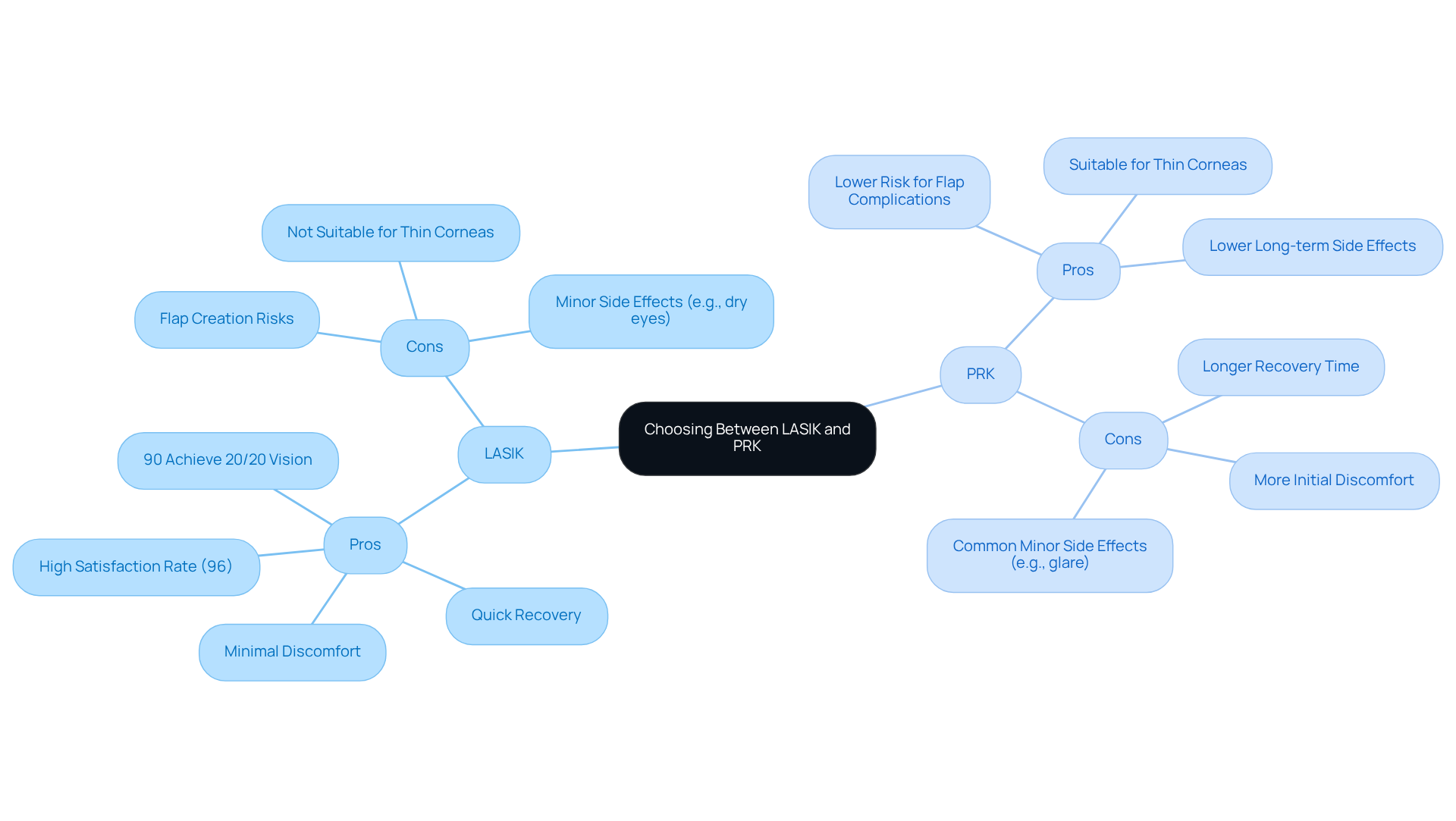
Conclusion
When weighing the options of LASIK and PRK, we understand that this decision can feel overwhelming. Both procedures offer unique benefits tailored to your individual needs. LASIK is celebrated for its rapid recovery and high satisfaction rates, making it a popular choice for those seeking quick visual improvement. On the other hand, PRK presents a viable alternative for individuals with specific eye conditions or those engaged in activities that may pose risks to flap integrity, despite its longer recovery timeline.
Throughout this article, we have highlighted key differences in procedures, recovery times, and potential risks. LASIK involves creating a corneal flap for immediate vision correction, while PRK removes the outer epithelial layer, resulting in a more gradual healing process. Understanding these distinctions is crucial for making an informed decision that aligns with your personal health needs and lifestyle considerations.
Ultimately, choosing between LASIK and PRK is a significant decision that should be made with careful consideration and professional guidance. We encourage you to consult with an experienced ophthalmologist who can provide clarity, ensuring that the selected procedure aligns with your vision goals and medical history. This choice not only impacts your immediate visual outcomes but also your long-term eye health. We are here to help you through this process, reinforcing the importance of thorough research and understanding in your journey toward clearer vision.
Frequently Asked Questions
What is LASIK and how does it work?
LASIK, or Laser-Assisted In Situ Keratomileusis, is a refractive eye surgery that corrects vision issues like myopia, hyperopia, and astigmatism. The procedure involves creating a thin flap in the cornea, lifting it, and using a laser to reshape the underlying corneal tissue, allowing for quick recovery and minimal discomfort.
What are the success rates for LASIK?
Over 90 percent of individuals undergoing LASIK achieve 20/20 vision or better after surgery, with satisfaction rates exceeding 95%.
What is PRK and how does it differ from LASIK?
PRK, or Photorefractive Keratectomy, is another laser eye surgery that corrects refractive errors by removing the outer layer of the eye’s surface (the epithelium) before reshaping it with a laser. Unlike LASIK, PRK does not involve forming a flap, making it suitable for individuals with thinner corneas or those engaged in contact sports.
What is the recovery time for LASIK compared to PRK?
LASIK typically allows for clear vision within a few hours after the procedure, while PRK generally requires a longer recovery time, with about 70% healing after one week and 90% after one month.
Are there any complications associated with LASIK or PRK?
Complication rates for LASIK remain below 1%, with around 0.3 percent of individuals potentially experiencing serious complications such as dry eyes and infection. PRK also has its own risks, but it is generally considered safe.
What conditions might affect the decision to undergo LASIK or PRK?
Conditions like Keratoconus, which causes the cornea to thin and develop an abnormal curvature, can complicate the decision-making process for eye surgeries. Those with Keratoconus may need specialized treatments before considering LASIK or PRK.
How can I determine which procedure is right for me?
It is essential to consult with an experienced ophthalmologist who can evaluate your individual needs and recommend the most suitable option based on your eye health and vision requirements.






